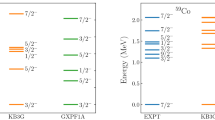Summary
One-body spheroidal Coulomb potential, in a collective model with Nilsson wave functions, is used to calculate the Fermi matrix elementsM F for the beta-decays of8Li and134Cs. Under the conserved-vector-current (CVC) theory, if there are no charge-dependent effects, theM F with ΔJ=0, ΔT=±1 should be zero. The finite values ofM F experimentally observed have to be ascribed to the isospin impurities which are introduced by the charge-dependent effects. Coulomb potential is usually considered to be the most obvious charge-dependent force. In our present work, estimates of the effects of the Coulomb forces in causing aT-admixture are in good accord with the observed impurities.
Riassunto
Si usa un potenziale sferoidale di Coulomb a un corpo, in un modello collettivo con funzioni d'onda di Nilsson, per calcolare gli elementi di matrice di FermiM F per i decadimenti beta del8Li e del134Cs. Secondo la teoria della corrente vettoriale conservata (CVC), se non ci sono effetti dipendenti dalla carica,M F con ΔJ=0, ΔT=±1 dovrebbe essere zero. I valori finiti diM F osservati sperimentalmente sono considerati come dovuti alle impurità di isospin che sono introdotte dagli effetti dipendenti dalla carica. Il potenziale di Coulomb è generalmente considerato come la più ovvia forza dipendente dalla carica. In questo lavoro le stime degli effetti delle forze di Coulomb nel causare una mescolanza diT sono in buon accordo con le impurità osservate.
Резюме
Для вычисления матричных элементов фермиM F для бета-распада8Li и134Cs используется одночастичный кулоновский потенциал в коллективной модели с волновыми функциями Нильсона. В теории с сохраняюшимся векторным током, если не сушествуют эффекты, зависяшие от заряда, матричный элементM F с ΔJ=0, ΔT=±1 должен равняться нулю. Конечные значенияM F, наблюденные экспериментально, должны описываться изоспиновыми примесями, которые обусловливают зффекты, зависяшие от заряда. Считается, что кулоновский потенциал представляет наиболее очевидную силу, зависяшую от заряда. Оценки зффектов, связанных с кулоновскими силами, хорощо согласуются с наблюдаемыми примесями.
Similar content being viewed by others
References
R. P. Feynman andM. Gell-Mann:Phys. Rev.,109, 193 (1958).
M. Gell-Mann:Phys. Rev.,111, 362 (1958).
C. T. Yap:Science Journal, University of Singapore,1, 19 (1967).
R. A. Ricci, R. K. Girgis andR. van Lieshout:Nucl. Phys.,21, 177 (1960)
H. Bakhru andI. M. Ladenbauer-Bellis:Phys. Rev.,184, 1142 (1969).
P. G. Hansen, H. L. Nielsen, K. Wilsky andJ. G. Cuninghame:Phys. Lett.,24 B, 95 (1967).
J. Damgard:Nucl. Phys. 79, 374 (1966).
R. J. Blin-Stoyle:Selected Topics in Nuclear Spectroscopy, edited byB. J. Verhaar (Amsterdam, 1964), p. 213.
E. M. Henley:Isobaric Spin in Nuclear Physics, edited byJ. D. Fox andD. Robson (New York, N. Y., and London, 1966), p. 3.
C. T. Yap andC. S. Tee:Nucl. Phys.,165 A, 497 (1971).
C. T. Yap andC. S. Tee:Nucl. Phys.,194 A, 573 (1972).
C. T. Yap andE. L. Saw:Journ. Singapore Nat. Acad. Sci.,3, 217 (1973).
C. T. Yap andC. S. Tee:Nucl. Sci. Journ.,12, 183 (1975).
J. D. Rogers:Ann. Rev. Nucl. Sci.,15, 241 (1965).
H. Friedrich andA. Weiguny:Phys. Lett.,35 B, 105 (1971).
S. G. Nilsson:Dan. Mat. Fys. Medd.,29, No. 16 (1955).
M. E. Nordberg jr.,F. B. Morinigo andC. A. Barnes:Phys. Rev.,125, 321 (1962).
A. Bohr andB. R. Mottelson:Mat. Fys. Medd. Dan. Vid. Selsk,27, No. 16 (1953).
C. T. Yap:Nucl. Phys.,100 A, 619 (1967).
H. F. Schopper:Weak Interactions and Nuclear Beta Decay (Amsterdam, 1966).
D. E. Raeside, J. J. Reidy andM. L. Wiedenbeck:Nucl. Phys.,93 A, 54 (1967)
A. S. Davydov andG. S. Filippov:Nucl. Phys.,8, 237 (1958).
C. A. Mallmann:Nucl. Phys. 24, 535 (1961).
S. K. Bhattacherjee, S. K. Mitra andH. C. Padhi:Nucl. Phys.,96 A, 81 (1967).
A. Christy andO. Hausser:Nucl. Data Tables,11, 281 (1972).
J. P. Davidson:Collective Model of the Nucleus (New York, N. Y., 1968).
S. T. Hsue, M. U. Kim, L. M. Langer andE. H. Spejewski:Nucl. Phys.,109 A, 423 (1968).
J. Damgard:Ark. Fys.,36, 651 (1967).
C. T. Yap andC. S. Tee:Nucl. Phys.,169 A, 609 (1971).
Author information
Authors and Affiliations
Additional information
Traduzione a cura della Redazione.
Переведено редакцией.
Rights and permissions
About this article
Cite this article
Saw, E.L., Yap, C.T. Isospin-forbidden beta-decays. Nuov Cim A 39, 643–654 (1977). https://doi.org/10.1007/BF02771036
Received:
Published:
Issue Date:
DOI: https://doi.org/10.1007/BF02771036




